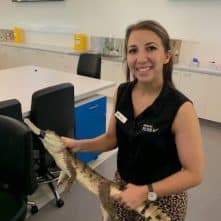Recently I was chatting with a fellow vet tech, now working in the imaging field, to find out some of the ins and outs of the technology and care of ultrasound machines.
Aimee Rapone, national sales representative for Medical Plus Australia, is a lovely, down to earth techy with great knowledge and experience in the veterinary industry. After working in Australia, South Africa and the UK, Aimee started with Medical Plus in 2019 and has taken the crocodile by the tail. Aimee is heavily involved in our Melbourne ultrasound workshops and loves guiding the vets around the many functions and buttons of the imaging machines.

How long have you been bringing MyLab ultrasound machines to vets across Australia?
Since 1993 Medical Plus has been providing all of Australia and New Zealand with Esaote Mylab ultrasounds.
What are the key benefits of having a MyLab in clinic?
The key benefits of having a Mylab ultrasound is that it provides veterinary specific software, with the highest standard image quality, functionality and reliability. By having a Mylab ultrasound in clinic a veterinarian is able to perform any scan on animals to help either diagnose, review, perform tests and/or collect samples. We have a range of portable ultrasounds available, or trolley based ultrasounds for in clinic use with a big monitor for easy viewing, plus all the different types of transducers/probes and accessories. You also receive local support from Australian based engineers.
In the past 5-10years how has the technology changed for the better? And how does that impact vets and their patients?
The technology has advanced a great deal in the past 5-10 years and is continuing to evolve. Image quality, functionality, workflow and size are all improving. Ultrasounds now provide a much crisper image with smaller probes and systems. This means we have a better selection of probes for veterinarians to use, which makes for easier and faster diagnosis.
How often should vets use ultrasound in their practice?
A veterinarian should perform an ultrasound when they need to investigate a pet’s health whether that is the gastrointestinal tract, glands, lymph nodes, or cardiovascular, musculoskeletal or urogenital systems. An ultrasound is a non-invasive tool which provides valuable information and could be used daily where appropriate.
For clinics branching into diagnostic ultrasound, what are the key factors that help determine what they need?
*Have a think about the types of scanning you’d like to do; point of care or emergency type scanning? Or would you like to perform more investigative scans, including echocardigraphs?
*The ultrasound itself can have many and varied capabilities. The appropriate transducers will vary depending on the type of scanning you’d like to do, and your skill set, so you might need to consider taking some continuing education.
*Also, what patients are you treating, and are you planning to use the ultrasound in clinic only, or out in the field as well?
What are your top tips for machine & probe care?
*A dim – dark room will help with visualisation during your scan and keep your patient calmer.
*Ensure the machine is always kept clean and free of dust and animal hair!
*It’s really important to take care with all probe types, especially when performing FNA, (fine needle aspirates) as the probe membrane is quite fragile.
*Store the machine in an appropriate place where it will not get damaged.
*Finally, ensure your studies/images are backed up regularly from the ultrasound.
If your journey into offering ultrasound is on the horizon, have a think about your next step. Or perhaps you have an ultrasound already and want to grow your skills. Although our workshop for 2020 is full you can join our waitlist, here, and be the first to know when the 2021 dates are being released.
VetPrac loves working with Medical Plus, quality products and fantastic people. It’s always a great workshop with them in the mix. See you at the next workshop!
